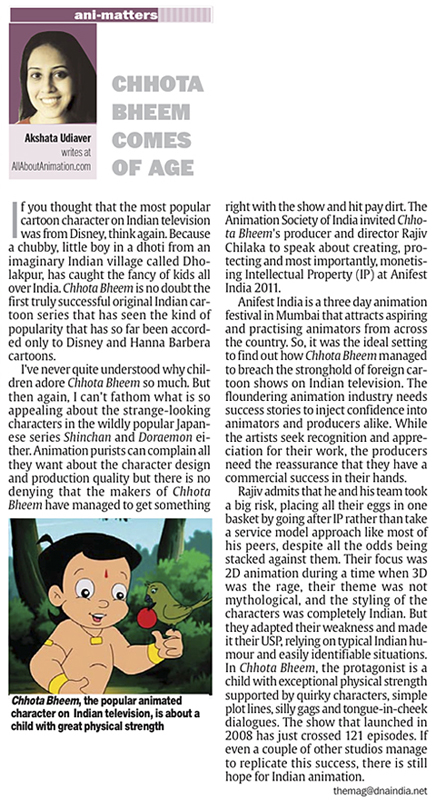* This article was originally published in DNA Sunday Mag (pg. 15) on 28th August 2011 – Download PDF *
If you thought that the most popular cartoon character on Indian television was from Disney, think again. Because a chubby, little boy in a dhoti from an imaginary Indian village called Dholakpur, has caught the fancy of kids all over India. Chhota Bheem is no doubt the first truly successful original Indian cartoon series that has seen the kind of popularity that has so far been accorded only to Disney and Hanna Barbera cartoons.
I’ve never quite understood why children adore Chhota Bheem so much. But then again, I can’t fathom what is so appealing about the strange-looking characters in the wildly popular Japanese series Shinchan and Doraemon either. Animation purists can complain all they want about the character design and production quality but there is no denying that the makers of Chhota Bheem have managed to get something right with the show and hit pay dirt. The Animation Society of India invited Chhota Bheem‘s producer and director Rajiv Chilaka to speak about creating, protecting and most importantly, monetising Intellectual Property (IP) at Anifest India 2011.
Anifest India is a three day animation festival in Mumbai that attracts aspiring and practising animators from across the country. So, it was the ideal setting to find out how Chhota Bheem managed to breach the stronghold of foreign cartoon shows on Indian television. The floundering animation industry needs success stories to inject confidence into animators and producers alike. While the artists seek recognition and appreciation for their work, the producers need the reassurance that they have a commercial success in their hands.
Rajiv admits that he and his team took a big risk, placing all their eggs in one basket by going after IP rather than take a service model approach like most of his peers, despite all the odds being stacked against them. Their focus was 2D animation during a time when 3D was the rage, their theme was not mythological, and the styling of the characters was completely Indian. But they adapted their weakness and made it their USP, relying on typical Indian humour and easily identifiable situations. In Chhota Bheem, the protagonist is a child with exceptional physical strength supported by quirky characters, simple plot lines, silly gags and tongue-in-cheek dialogues. The show that launched in 2008 has just crossed 121 episodes.
If even a couple of other studios manage to replicate this success, there is still hope for Indian animation.

